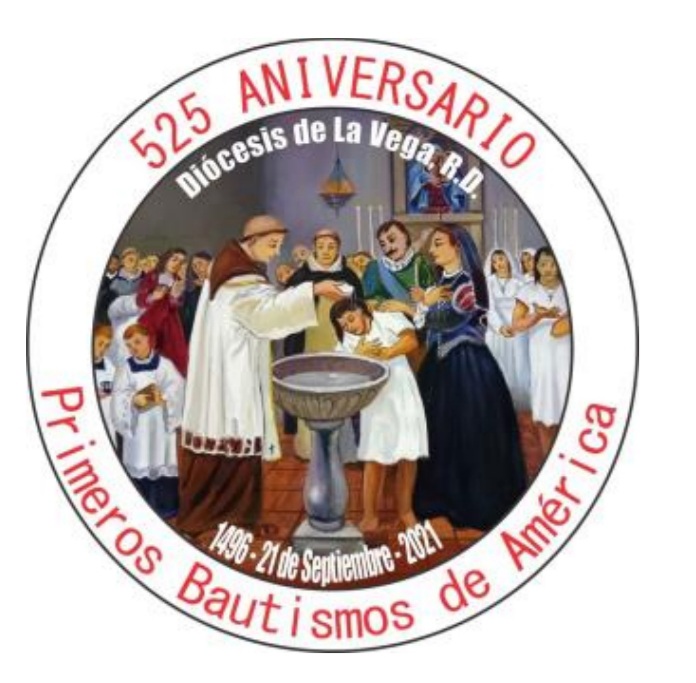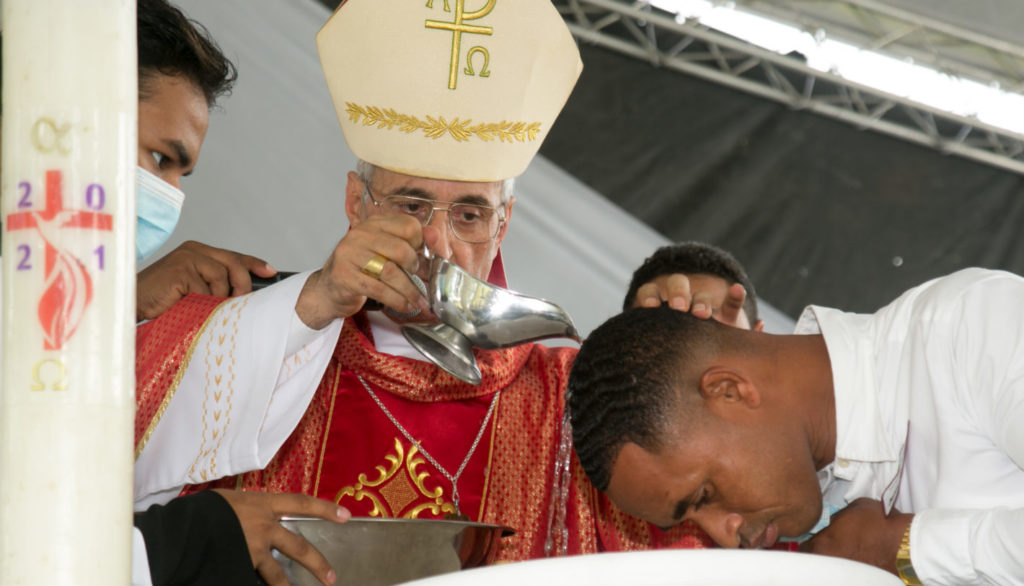On August 3, 1492, a group of 120 people left Spain. Admiral Christopher Columbus was in command. There were no priests in that group. Two months later, on October 12, they found land. On the night of December 24, 1492, the Admiral retired to rest and left the rudder of the caravel Santa Maria to a sailor; but it ran aground on a sandbank and the ship had to be scrapped and the wood was used to build the Fort of Christmas, where 39 members of the crew would remain, unable to return to Spain. This fact would force them to return to this site on a second voyage.
On September 25, 1943, a second voyage set sail. This time it was to occupy the land and was made up of 14 caravels and 3 galleons. The contingent was 1,500 men, including 13 missionaries. They found that the fort had been destroyed and, bordering the north coast, they found a place to settle and founded La Isabela, the first settlement in these lands. There, Friar Bernardo Boíl celebrated the first Mass in America on January 6, 1494. Among the religious was Friar Ramón Pané, who evangelized the Guaticaba Indian and his family, already inland, in the foundation of La Concepción de La Vega, currently at the foot of the Santo Cerro, where the Virgin of Las Mercedes, Patron Saint of the Dominican people, is venerated. The cacique Guaticaba was given the name of Juan Mateo, because he received the baptismal waters on September 21, feast of the Apostle San Mateo.

From this brief summary we can see how God, who wants everyone to be saved, set his sights on this continent and it was the caravel La Santa Maria that ran aground precisely on Christmas Eve, and with its debris the Fortress of Christmas was built. The need to return to this same place and the celebration of the first Mass on the day of the Epiphany of the Lord - of the manifestation to those who were not God's people.
And the first baptisms on the feast of St. Matthew the Apostle, of whom St. Bede Venerable comments on the account of the vocation of St. Matthew, Our Lord misernado atque eligendo, looking upon him with mercy chose him. God had mercy on all these people and chose them to be his children. Other Indians had already been baptized in Spain, but this was the first time that baptism was administered on the American continent, in the second settlement, which would be abandoned by the earthquake of 1562. Guaticaba and his family would also be the first martyrs of indigenous origin because they were sacrificed by other Indians and they remained faithful to their faith.
Preparation for the Jubilee
The Dominican Episcopal Conference decided that the Jubilee celebration would be held in the ruins, now called Vega Vieja, and that a commemorative chapel would be erected there.
In the diocese of La Vega the preparation for the Jubilee has been logically more intense. The limitations imposed by the pandemic have not been an obstacle for a capillary catechesis and the use of radio, television and social networks. There have been virtual conferences given by specialists, catechesis on the sacrament of Baptism and the meaning of the various rites of the ceremony, and programs aimed at the renewal of faith and baptismal promises, which have been done in the parishes, plan of Sunday homilies until the next celebration of the Baptism of the Lord in January 2022, celebration of baptisms in the parishes, parish visits to the ruins of the Vega Vieja, where the first baptisms took place, etc.
A concelebration was also held in the Cathedral, presided by Bishop Rafael Rodriguez, Bishop of La Vega, in which the presbyters and deacons, who exercise their ministry in the diocese, renewed their baptismal promises. A press conference was held at the City Hall of La Vega with the participation of the Bishop and Mr. César Arturo Abreu, historian, to promote the Jubilee.
Jubilee Celebration
On September 21, in the esplanade of the ruins of La Vega Vieja, the place where the first baptisms took place, at 9:00 a.m., the Solemn Concelebration took place, presided by the Apostolic Nuncio in the Dominican Republic, Mons. Rafael Rodríguez, Bishop of La Vega and the other Bishops of the Dominican Episcopal Conference, as well as the clergy of the Diocese of La Vega and Pastoral Vicars of the other dioceses. Some civil and military authorities and a small number of faithful attended, due to the circumstances of the place and the pandemic.
The Solemn Concelebration was transmitted to the entire American continent by numerous television, radio and social media. Many Bishops from the American countries sent messages of congratulations, unity and joy for this event.
At the beginning of the Concelebration, Bishop Rafael Rodriguez, Bishop of the Diocese of La Vega, welcomed the attendees and the television, radio and social media audience, and went on to read the message sent by the Holy Father on the occasion of this Jubilee. He announced his desire to build a modest but significant temple where the baptismal promises are remembered and renewed, and invited the Ministries of Culture and Tourism to collaborate in this project.
The Concelebration was presided over by Bishop Ghaleb Bader, His Holiness' Nuncio to the Dominican Republic. In his homily he pointed out the transformation that the administration of the first baptisms brought to this part of the world. The first Eucharist and the first baptisms gave this New World Jesus Christ, the Gospel and the Church.
Then the water was blessed and the baptismal promises were renewed and the Sacraments of Christian Initiation were administered to twelve adults. After the reception of the Holy Eucharist, the engineer Kelvin Cruz, Mayor of La Vega, addressed some moving words and joined the desire of the Bishop of the diocese that a commemorative temple be erected in this very dear place, and that this ceremony would not be inconsequential. The Pastoral Vicar of the diocese gave thanks and ended the Concelebration after the solemn blessing.
Omnes Correspondent in the Dominican Republic









